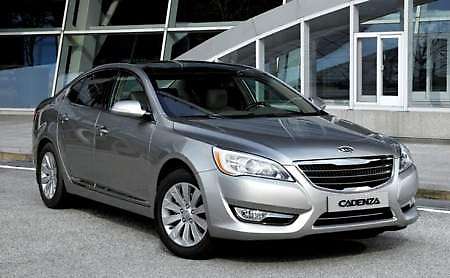
Kia has officially launched the all new Cadenza “luxury sports sedan” in Korea where it is simply called the K7. Along with the launch the automaker also revealed that the Cadenza will go on sale worldwide sometime next year after making its world debut at the Riyadh Motor Show in Saudi Arabia on 12 December. The Cadenza measures 4965 mm long, 1850 mm wide, 1475 mm high and has a wheelbase that is figured at 2845 mm, and just for the sake of comparing the latest E-Class has a 2874 mm wheelbase.
The 2065 kg sedan is powered by a transversely-mounted 3.5 litre Lambda II V6 that can produce 290 PS at 6600 revs and 338Nm of torque at 5000 revs. The engine is paired with a 6-speed automatic transmission with sequential manual mode. According to Kia, 0 – 100 km/h would take 7.2 seconds while top speed is rated at 230 km/h.

Kia also revealed that two more engine options will be available as well, positioned below the V6. These engines will have power outputs starting from 165 PS. Suspension wise it has a MacPherson strut setup up front while the rear is treated to a multi-link configuration. With the above V6 unit, the vehicle has an estimated fuel consumption figure of 9.36 litre per 100 km (combined).
Exterior highlights include LED position lights up front, taillights also with LEDs as well as a full-length three-part glass panoramic roof that will be available as an option. Interior features include a ‘welcome’ system, mood lighting strip that runs across the two-tier dashboard and all around the door trims, dual-zone climate control, keyless entry, engine ‘start’ button, a reversing safety camera with interior mirror display screen and more. My impression of the Cadenza? Not bad. Continue reading to view an image gallery that includes some shots of the interior as well as to watch a video of the Kia Cadenza.
[zenphotopress number=99 album=642]
Looking to sell your car? Sell it with Carro.

















AI-generated Summary ✨
Comments generally express positive excitement about the Kia Cadenza’s modern, European-inspired design, with some noting its resemblance to Audi and BMW models, reflecting a breath of fresh air in Korean automotive styling. Many highlight the impressive progress of Korean car manufacturers, contrasting their advancements with Malaysia’s automotive industry, particularly Proton, which some feel is lagging behind in technology, design, and innovation. Price is praised as competitive, with hopes that local companies like Naza might bring in the model more affordably. There's also discussion on the car’s weight and engine options, with some wishing for a turbo version. Overall, sentiments are optimistic about Kia’s progress and desire for Malaysia to develop similarly, though a few off-topic comments criticize local industry performance.